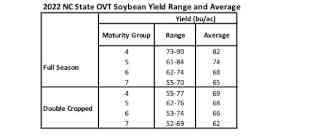By Mike Carroll
While climatic factors are often indeed the determining factor for yield within Eastern North Carolina, the weather and climate conditions are beyond an agricultural producer’s control. However, two significant factors of soybean yield that agricultural producers can control are the selection of variety and planting date. NC State research has repeatedly enforced that earlier planting is not only possible, but prudent. And, to be clear, these replicated studies have begun planting in mid-March. As such, each grower should evaluate planting practices to plan for early planting of soybean if high yield is desired. All full season soybeans should be targeted to be planted by early May. Data also show that planting earlier maturing varieties favor higher yield. Note the yield range and average for 2022 data below.

The second factor, selection of variety is a bit more complicated. Selection of a variety should include resistance to known disease or nematode populations, desired harvest date, and storage/transport considerations. High yield (80 bu/ac or higher) is possible with many varieties so these other factors, rather than simply yield, should be considered a priority. To select parameters that fit your operation (soil type, days above 95 degrees F, population, disease resistance, etc.) simply utilize the NC Variety Selection Tool. To begin discovery, first examine which soybean maturity group seems feasible. Data consistently shows that high yield is most likely with earlier maturing varieties when planted early. The chart below shows the percent of varieties tested in 2022 divided into two yield ranges: 1) 80+ bu/ac (blue); and, 2) between 70-80 bu/ac (orange) for full season planted soybeans. Note that almost 70% of Maturity Group IV soybeans yielded 80 bu/ac or greater compared to only about 15% of Maturity Group V. No soybeans within Maturity Groups VI or VII yielded this high. Note that a bit over 30% of the Maturity Group IV were between 70-80 bu/ac. Thus, 99% of Maturity Groups IV & V yielded at least 70 bu/ac.

When examining multiple year data, this trend continues. Note that when using 2020-2022 data 100% of soybeans within Maturity Group IV yielded 80 bu/ac or greater. This is far greater than any other maturity group. When examining yield between 70-80 bu/ac Maturity Groups V & VI had about 65-75% of the varieties with yield in this range.

While this again, emphasizes the higher yield potential of earlier maturity groups, it is also critical to understand a bit more about the data. First, for any given year, it is possible to have 50 or more varieties in a trail. Those that do not have yield above about 70 bu/ac or critical disease resistance are likely to be abandoned. As such, over the years, the number of varieties consistently performing well decreases. As such, data with three years may show only 15-20 varieties. Another critical factor is that this data represents averages. As such, it is possible to find 80-100 bu/ac yield among Maturity Groups V- VII. These charts simply show the yield of varieties tested. This is critical to understand. The data show that the likelihood of high yield is greater with earlier maturity groups. However, if early maturity groups simply do not fit in your risk or management, it is still possible for high yield with good selection. Simply examine the data from the NC Varietal Selection Tool It is also critical to note another factor. Those seeking to increase yield with any type of yield enhancement product are less likely to realize results on later maturity groups than for earlier ones. Simply put, the climatic factors, growing environment and genetic breeding is simply not quite as favorable than earlier planting and earlier maturity groups. For those planting double cropped behind wheat or face later than desired planting for whatever reason, note that such yield above 80 bu/ac is not typically possible. When averaging data over the last three years, no maturity group had 80 bu/ac when planted late. The chart below shows the percent of varieties tested that yielded between 70-80 bu/ac. Note that earlier maturing varieties are still slightly favored, but maturity groups V & VI are similar. Maturity Group VII did not have any varieties above 70 bu/ac.

Source : ncsu.edu